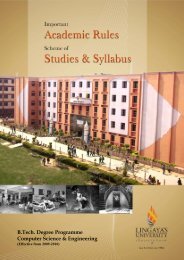Electrical and Electronics - Lingaya's University
Electrical and Electronics - Lingaya's University
Electrical and Electronics - Lingaya's University
Create successful ePaper yourself
Turn your PDF publications into a flip-book with our unique Google optimized e-Paper software.
Lingaya’s <strong>University</strong>, Faridabadcoordinates approach; Triangular elements <strong>and</strong>quadrilateral elements ; convergence criteria forchosen models; Interpolation functions; Elementsmatrices <strong>and</strong> vectors; Assembly of elementmatrices; boundary conditions; solutiontechniques.5. ISOPARAMETRIC ELEMENTS ANDFORMULATION: Natural coordinates in 1, 2<strong>and</strong> 3 dimensions; use of area coordinates fortriangular elements in; 2 dimensional problems;Isoparametric elements in 1, 2 <strong>and</strong> 3 dimensions;Largrangean <strong>and</strong> serendipity elements;Formulation of element equations in one <strong>and</strong> twodimensions ; Numerical integration.6. APPLICATIONS TO FIELD PROBLEMS IN TWODIMENSIONS: Equations of elasticity; planeelasticity problems; axisymmetric problems inelasticity; Bending of elastic plates; Timedependent problems in elasticity; Heat transfer intwo dimensions; Incompressible fluid flow <strong>and</strong>related problems.7. INTRODUCTION TO ADVANCED TOPICS (NOTFOR EXAMINATION PURPOSES; Threedimensional problems; Mixed formulation; use ofsoftware packages.TEXT BOOKReddy J. N., ―An Introduction to Finite ElementMethod‖, McGraw Hill, Intl Student EditionREFERENCE BOOKS1 Zienkiewitch, "The Finite Element Method; BasicFormulation <strong>and</strong> Linear Problems", Vol 1, 4thEdition, McGraw Hill2 Desai C. S. <strong>and</strong> Abel J. F., "Introduction to theFinite Element Method", Affiliated East west Press,19723 Rao S. S., ―The Finite Element Method inEngineering‖, Pergaman Press, 1989ME-461RENEWABLESOURCES OF ENERGYL T P Cr5 0 0 3OBJECTIVEThis gives the knowledge of estimation; conversion <strong>and</strong>utilization of non conventional sources of energy. Withthe depletion of fossil fuel sources, the importance ofnon-conventional renewable sources of energy hasgained tremendous importance. This courseintroduces the students to these sources <strong>and</strong> howthese can be utilized for power production.1. INTRODUCTION: Trends of energy consumption;sources of energy; conventional <strong>and</strong> Renewable;fossil fuel; availability <strong>and</strong> limitations; need todevelop new energy sources.2. SOLAR ENERGY: Solar radiation characteristics<strong>and</strong> estimation; Solar Collectors; Flat Plate <strong>and</strong>concentrating types; Their comparative study;design <strong>and</strong> material selection; Efficiency; Selectivepaints <strong>and</strong> surfaces; Heating of air <strong>and</strong> water forbuilding <strong>and</strong> other Uses; Thermal storages; SolarPonds; Solar pumps; solar Power; Solar Cookersetc; Direct Conversion of Solar energy to electricity<strong>and</strong> its various uses; materials; limitations <strong>and</strong>Costs.3. BIO-CONVERSION: Generation of bio-gas;digesters <strong>and</strong> their design; selection of material;feed to digester; paralytic gasification; productionof hydrogen; Algae production <strong>and</strong> their uses.4. WIND ENERGY: Types of rotors; horizontal axis<strong>and</strong> vertical axis systems; system design <strong>and</strong> siteselection.5. GEO-THERMAL ENERGY: Sites; potentiality <strong>and</strong>limitation; study of different conversion systems.6. TIDAL ENERGY: Sites; potentiality <strong>and</strong> possibilityof harnessing from site; limitations; Ocean ThermalEnergy: Principle of utilization <strong>and</strong> its limitations;description of various systems.7. OTHER NON-CONVENTIONAL ENERGYSOURCES: Fluidized bed combustions; heat fromwaste <strong>and</strong> other sources.TEXT BOOKTiwari G. N. <strong>and</strong> Ghosal M. K., ―Renewable EnergyResources‖, Narosa Publishing HouseREFERENCE BOOKS1. Rai G. D., ―Solar Energy Utilization‖, KhannaPublishers, 19952. Duffie J. A. <strong>and</strong> Beckman, ―Solar Heating <strong>and</strong> Cooling‖3. Wakil M. M, EL, ―Power Plant Technology‖,McGraw Hill4. Sharma P. C., ―Power Plant Engineering‖, S. K.Kataria <strong>and</strong> SonsPH-471NON DESTRUCTIVETESTING TECHNIQUESL T P Cr5 0 0 3OBJECTIVETo give a general overview of novel non destructivetesting methods, the principles behind them, their uses,the advantages <strong>and</strong> limitations, both in application <strong>and</strong>defect detection capability.1. NON-DESTRUCTIVE TESTING: Non-destructivetesting (NDT): role, components <strong>and</strong> advantages;common NDT techniques.2. ULTRASONIC TESTING: ultrasonic flawdetection: principle, working <strong>and</strong> applications,advantages <strong>and</strong> limitations.3. RADIOGRAPHY: X-ray radiography, Gamma myradiography <strong>and</strong> Neutron radiography; principle,working <strong>and</strong> applications, advantages <strong>and</strong> limitations.4. EDDY CURRENT TESTING: Principle, working<strong>and</strong> applications of eddy current testing; probes<strong>and</strong> sensors; testing procedures, applications,advantages <strong>and</strong> imitations.5. MAGNETIC TESTING: Magnetic testing: particle,flux leakage testing; magnetization methods;detectables. applications <strong>and</strong> imitations,6. DYE PENETRANT TESTING: Principle, working<strong>and</strong> applications of dye penetrant testing,advantages <strong>and</strong> limitations.7. VISUAL AND OPTICAL TESTING: Principle, workhg<strong>and</strong> applications of holography, optical interferencetechniques, advantages <strong>and</strong> limitations.TEXT BOOKBaldev Raj, Jayakumar T., <strong>and</strong> Thavasimuthu M.,―Practical Non-Destructive Testing‖, Narosa Publishing,199761
















